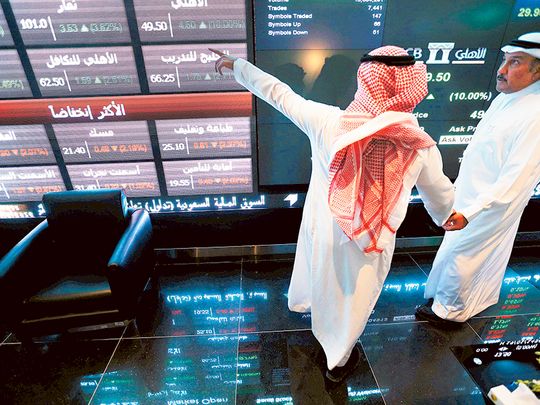
Dubai: The pressure is building in Saudi Arabian markets.
Interbank lending rates are creeping up, bonds are sliding and the cost of insuring against a debt default is rising as the Arab world’s biggest economy adjusts to a collapse in the price of oil, which generates at least 80 per cent of government revenue. Standard & Poor’s lowered the country’s credit rating last week, citing a budget deficit that it forecasts will increase to 16 per cent of gross domestic product this year.
Saudi Arabia’s three-month interbank offered rate, the amount banks charge each other to lend cash and a benchmark used to price loans, is climbing as customer-deposit growth in the kingdom slows. It rose to 1 per cent Thursday, the highest level since April 2009.
“It’s indicating a substantial build-up of stress in the local financial system,” Michael Shaoul, the chairman at Marketfield Asset Management LLC in New York, said in an e- mailed note. “The budgetary woes emanating from crude oil’s price collapse seem much more chronic in nature” and will require a domestic response, he said.
CDS equivalent to lower-rated India
Though Saudi Arabia has no external sovereign debt, the theoretical cost to insure against a default as measured by credit-default swaps rose this week to 156 basis points, the most since June 2009. While S&P rates the kingdom A+, the fifth- highest investment grade, the swaps are trading at similar levels to those for Panama, Hungary and India, which are ranked at least four grades lower by S&P.
“The risk perception for GCC credit is slowly becoming more cautious and pressure will increase if oil does not break back to the $60-a-barrel range within the next six months or so,” said Apostolos Bantis, a credit analyst at Commerzbank AG in Dubai.
Bonds lagging behind regional peers
Bonds of Saudi Electricity Co., the power company more than 74 per cent-owned by the government, fell to the lowest in 18 months this week, with yields jumping 21 basis points on Monday alone. They have risen 34 basis points in the past month, compared with a two basis-point increase for the average yield on Middle East bonds, according to JPMorgan Chase & Co. indexes.
The securities were also downgraded by S&P on Wednesday.
“Saudi CDS and spreads on the SECO curve imply material repayment risk, which is simply not the case for a country with Saudi’s resources, regardless of $50 oil,” Akber Khan, the director of asset management at Doha, Qatar-based Al Rayan Investment LLC, said by email on Tuesday. This may be a “great buying opportunity but that doesn’t guarantee there won’t be more panic selling,” he said.
Stocks may become cheaper than emerging market peers
The Tadawul All Share Index (Tasi) closed at the lowest in almost three years on Tuesday as Bank of America Corp said the country’s creditworthiness may deteriorate further.
The forward price-to earnings ratio of stocks on the gauge is poised to drop below that of shares on the MSCI Emerging Markets Index for the first time since December, according to data compiled by Bloomberg. The last time oil languished at these levels, they traded at a discount to developing-nation stocks for the longest period on record.












